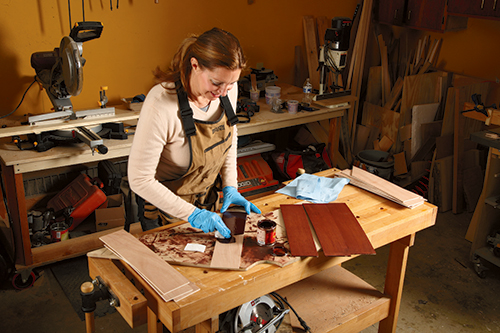
Can wood be over sanded to the point it won’t take stain? I have been working with pine and it seems the more I sand, the harder it is to get the wood to take any stain.
Jeff Jewitt: Absolutely. Sanding pine and smooth textured hardwoods actually prevents pigment-based stains from staining the wood very dark. Sanding creates tiny scratches in the wood that the pigment particles grab onto and sanding above 150 starts to diminish the staining ability of the stain. One problem is that 150 leaves visible marks if you use a power sander so you’ll have to sand by hand with 150 in the direction of the grain when you’re done power sanding with 150. Another option if you prefer to sand to 220 is to use a dye stain which doesn’t depend on texture or sanding scratches to color the wood.
Kevin Hancock: I would stop sanding most woods at 150-180 grit. Many dense hardwoods like maple will not hold pigments at all if sanded too fine.
Greg Williams: Yes, pigmented stains depend on surface irregularities, or unevenness to “hold” or “take” the stain. Think of the pigment particles (the color) as lodging in small valleys on the surface of the wood. Sanding the wood to a very smooth surface presents less of this “texture” to hold the stain.
Very tight-grained woods such as maple can be sanded so smoothly that very little of a pigmented stain will remain on the surface after wiping down the stain. Sanding more coarsely will allow more stain to remain on the surface. However, sanding too coarsely may result in visible sanding scratches as the pigment lodges in the scratch pattern.
Most soft woods don’t need to be sanded any finer than 220 grit. (CAMI scale), or coarser than 150 for the final sanding, depending on the stain, and the look you want. Minor differences in the wood can be a factor also. The cut of the wood (plainsawn, quartersawn, rotary sliced veneer) can make a difference in how the stain takes, as can the moisture content of the wood.
Dye stains, which penetrate the wood rather than lay on the surface, depend on the absorbency of the wood, not the topography. To get a very even and deep color on tight-grained woods, some finishers apply a dye stain followed by a pigmented (wiping) stain.





